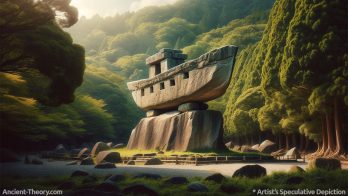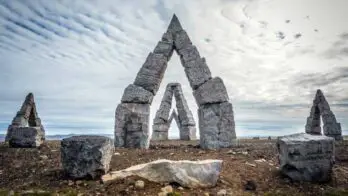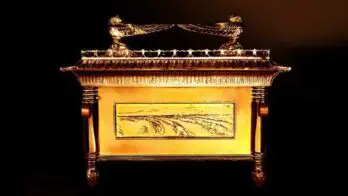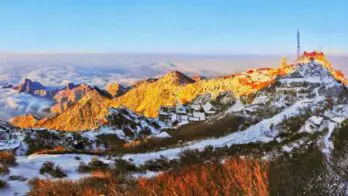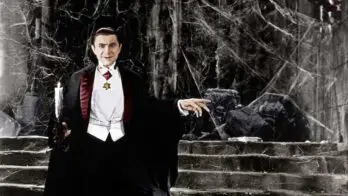The Viracochas people originated in the region that is present-day Bolivia and has been responsible for some of the most impressive architectural, technological, and cultural achievements between the 5th and 18th centuries.
When the Spanish conquerors first visited the ruins of the Bolivian city of Tiahuanaco, they were awestruck by the size of the structures and the air of mystery surrounding them.
Pedro Cieza de Leon, a chronicler, noted in his journals:
I asked the locals if these buildings had been constructed during the Inca period, and they laughed at the question and told me that they had been made far before the reign of the Incas.
They had heard from their ancestors that everything seen there had appeared in a single night.
The locals called these mysterious ancestors’ Viracochas,’ which means ‘winged people.’
Who Was Viracocha, the White God?
Viracocha, also known as Wiracocha, Apu Qun Tiqsi Wiraqutra, and Con-Tici, is a prominent creator deity in pre-Inca and Inca mythology in the Andes region of South America.
Viracocha held an important place in the Inca pantheon and was regarded as the creator of all things or the substance from which all things are created.
He is closely associated with the sea and is believed to have created the universe, the Sun, the Moon, the stars, time, and civilization itself by commanding the sun to move over the sky.
As the god of the sun and storms, Viracocha was depicted wearing the sun as a crown, with thunderbolts in his hands and tears descending from his eyes as rain.
Several Spanish chroniclers, including Pedro Cieza de León and Juan de Betanzos, referred to Viracocha as a “white god,” often portrayed with a beard.
The bearded appearance of Viracocha, similar to other deities like Quetzalcoatl of the Aztecs and Bochica of the Muisca, is common in Central and South American legends.
It is important to note that the physical appearance of Viracocha is open to interpretation.
However, the Peruvian Moche culture had been depicting bearded men in their famous pottery long before the arrival of the Spanish.
Viracocha’s mythical significance in the Andean region is evident from various sources.
In Inca cosmogony, he created the universe, which suggests that he played a crucial role in shaping the Andean worldview.
Furthermore, his association with the sea, sun, and storms implies that Viracocha had a profound impact on the daily lives of the Andean people, influencing various aspects of their culture, including agriculture and religion.
How Did Viracocha Create Humans?
The story of Viracocha, the creator deity in the Inca pantheon, is one of great significance.
According to the myth, Viracocha emerged from Lake Titicaca or the cave of Pacaritambo during the time of darkness to bring forth light.
He was said to have made mankind by breathing life into stones, but his first creation were brainless giants that displeased him. Therefore, he destroyed them with a flood and created a new, better creation from smaller stones.
Afterward, Viracocha wandered the earth disguised as a beggar, teaching his new creations the basics of civilization while working numerous miracles.
He wept when he saw the plight of the creatures he had created, and it was believed that he would reappear in times of trouble.
Pedro Sarmiento de Gamboa described Viracocha as “a man of medium height, white and dressed in a white robe like an alb secured round the waist, and he carried a staff and a book in his hands.”
In some legends, Viracocha had one son, Inti, and two daughters, Mama Quilla and Pachamama.
He destroyed the people around Lake Titicaca with a Great Flood called Unu Pachakuti, saving two to bring civilization to the rest of the world: Manco Capac, the son of Inti, and Mama Ocllo, who founded the Inca civilization while carrying a golden staff called ‘tapac-yauri.’
In another legend, he fathered the first eight civilized human beings, and in some stories, he had a wife named Mama Cocha.
Viracochas, the Builders of the Great City Tiahuanaco
Tiahuanaco was initially built as a port along the shores of Lake Titicaca when the lake was much wider and over 100 feet (30 meters) deeper than it is today.
Extensive port constructions, dykes, docks, and even abandoned loads of raw stone confirm this conclusion.
Indeed, estimates by professor, navigator, explorer, and archaeologist Arthur Posnansky (1873–1946) suggest that Tiahuanaco was an active port as early as 15,000 BC, the time at which Kalasasaya is believed to have been built and that it continued to serve as a port for more than 5,000 years without significantly changing its position to the shore.
Within this span, the main port was located a few hundred meters southwest of Kalasasaya, at a location known today as Puma Punku (eng. Gate of the Puma).
Here, Posnansky’s excavations revealed two artificially drained docks on either side “of a true and magnificent embankment where hundreds of ships could tie up at once to load and unload merchandise.”
One of the building blocks from which the embankment had been fashioned still lies there, weighing approximately 440 tons.
Other blocks weigh between 100 and 150 tons. Furthermore, I-shaped metal clamps have joined most of these monoliths.
Throughout South America, such a construction technique had only been discovered at the ruins of Tiahuanaco.
Only on the island of Elephantine along the Nile in Upper Egypt can we observe similar trenches made for such clamps in the ruins of stone blocks.
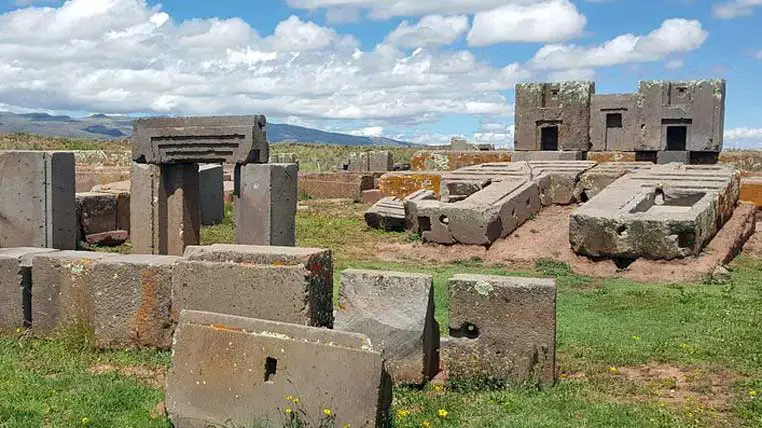
The Enigmatic Puma Punku
Puma Punku is an awe-inspiring sight. Its outer perimeter, forming a rectangle of approximately 100 meters, encloses a low hill covered in tall grass that resembles a pyramid.
Scattered around are numerous massive stone blocks, resembling, as observed by Posnansky, those discovered at Tiahuanacom following the catastrophic natural disaster that devastated the city in the eleventh millennium BC.
This disaster was caused by seismic movements, leading to the overflow of Lake Titicaca and volcanic eruptions.
The temporary rise in water levels was due to the breaking of dams on the upstream lakes at a higher altitude, releasing water that rushed towards Lake Titicaca in unstoppable torrents.
Posnansky provided additional evidence to support the hypothesis that a flood had ravaged Tiahuanaco and Puma Punku.
The discovery of lacustrine fauna, such as Paludestrina culminate, Paludestrina andecola, Ancylus titicacensis, and Planorbis titicacensis, mixed with human skeletons that had perished in the cataclysm, was one of them.
Human and animal skeletons were also found lying in complete chaos among stones, tools, utensils, and other items. These objects were moved, broken, and piled in an amorphous mound.
Anyone who digs a trench only two meters deep cannot deny the destructive force of the waters, which, combined with the sudden movements of the terrain, gathered all these different bones together, mixing them with fragments of pottery, jewelry, and some tools.
Layers of alluvium cover the entire field of ruins, and lake sand mixed with shells from Lake Titicaca and volcanic ash has accumulated in the squares surrounded by walls.
Indeed, the catastrophe that destroyed Tiahuanaco and Puma Punku was terrible.
Could this natural disaster be responsible for the mysterious migration of the Viracochas people? If Posnansky is correct, the flood occurred over 12,000 years ago.
Although the waters later receded, “the culture of the Altiplano never rose to a high level of development again, but completely and definitively declined.”
This observation supports the theory that the “chosen people,” the Viracochas, left Tiahuanaco and migrated westward.
However, the discovery of the cross symbol on numerous stone blocks in the northern area of Puma Punku raises even more intriguing questions.
The symbol, deeply engraved in stone, is a double cross with a balanced, harmonious outline and consistently similar shape.
Even using traditional chronologies, these crosses are estimated to be around 1,500 years old, predating Christianity by a millennium in the Altiplano region.
So how did these symbols get there, and what was their significance to the Viracochas people?
They had no contact with Christians, so they must have derived it from more than just the shape of the structure on which Jesus Christ was crucified but also from a much older source.
The Secrets of an Artificial Language
The language spoken by the Aymara Indians, believed by some specialists to be the oldest language in the world, is one of the strangest legacies of Tiahuanaco and the Viracochas people.
In the 1980s, Bolivian computer specialist Ivan Guzman de Rojas unintentionally proved that the Aymara language is not only ancient but a constructed language deliberately designed with great skill.
What is truly remarkable about the Aymara language is the apparent artificiality of its syntax, which is rigidly and unambiguously structured to such an extent that it seems inconceivable for a natural, “organic” language.
The synthetic and well-organized structure of the language suggests that Aymara could be transformed into a computerized algorithm to facilitate translation from one language to another.
According to Ivan Guzman de Rojas, the Aymara algorithm can be used as a bridge language. The original document is first translated into Aymara and then into any other language.
Could it be just a coincidence that the language spoken around Tiahuanaco has a “computer-friendly” syntax?
Alternatively, is the Aymara language the legacy of the great teachings attributed by legends to the Viracochas people?
If so, what other legacies might exist? What other incomplete fragments of an old and forgotten wisdom might be hidden, pieces that contributed to the wealth and diversity of many cultures that evolved in this region 10,000 years before the Spanish conquest?
Did those who created the Nazca lines or the Inca predecessors who built Machu Picchu and Sacsayhuaman’s “impossible” stone walls possess such fragments of wisdom?
Local myths and legends still speak of the Viracochas people who left “walking on the waters” of the Pacific Ocean or “miraculously stepping on the sea.”
Where did these navigators go? What were their goals? And why did they make such great efforts to stay at Tiahuanaco for so long? What did they try to accomplish here that was so important to them?
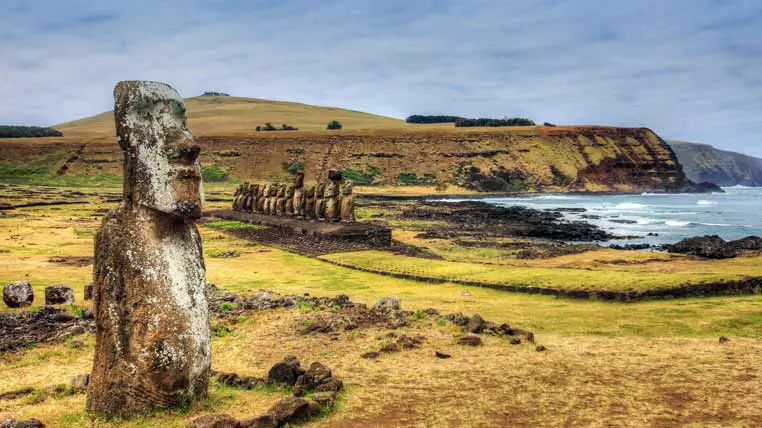
The Mystery Continues on the Easter Island
When Dutch explorer Jacob Roggeveen (1659-1729) arrived on Easter Island in 1772, he was astounded to find a society consisting of two distinct ethnic groups, in addition to the remarkable statues that still exist today.
The first and more populous group belonged to the brown race of Oceania. The second group, known as the noble caste, comprised tall, fair-skinned individuals with red or blond hair and ears artificially lengthened by hanging hooks 4-6 inches (10-15 centimeters) from their lobes.
The Spaniards observed similar ear-lengthening practices among the white ruling families of the Inca Empire, forming the military caste of orejones (Spanish for “long ears”).
According to the Easter Islanders’ traditions, their ancestors arrived on the island from the east around 400 AD, 57 generations before the Dutch explorer’s arrival in 1772.
Polynesians (people with “short ears”) came from the west (Polynesia) 22 generations before the Dutch explorers’ arrival. The Polynesians were welcomed by the “long ears” with friendship.
For some time, the two ethnic groups coexisted, but the cultural, lifestyle, and ideological differences eventually led to war.
The Polynesians, who lived off the land and only worked for their daily sustenance, could not comprehend the “long ears'” almost fanatical inclination towards work and creativity.
Due to their cunning, warrior instinct, and numerical superiority, the Polynesians emerged victorious in their battle against the “long ears,” massacring them all sometime between 1660-1700.
The archaeological findings of an expedition led by Thor Heyerdahl, an ethnographer, biologist, and Norwegian scientific explorer in zoology and geography, in 1947 validated that the “white-haired people” were killed and discarded from “Iko’s Ditch,” a massive defensive structure that the “long ears” created, beginning in the 400s AD.
This true line of defense, with the ditch alone measuring 2,5 miles long, 42 feet wide, and 13 feet deep, separated the Poike Peninsula from the rest of the island and could not be conquered by the “short ears” without the help of traitors.
The only survivor of the massacre was a young man named Ororoina, whose descendants, encountered by the Dutch in 1772, had succeeded one another for 12 generations in the island’s leadership.
Viracochas’ Astonishing Accomplishments
Viracochas people’s achievements on Easter Island are impressive for a population of no more than 2,000.
Their accomplishments include nearly 1,000 colossal statues, platforms, stone ramps, galleries, fortresses, caves, and quarries carved into hard rock. Additionally, the sacred village of Orongo was built, which boasted an “astronomical observatory” atop the Rano Kao volcano.
Legends suggest that a portion of the Viracochas people landed on the island, which is said to be the origin of Easter Island’s unique “frigate-men” cult.
Many engravings and sculptures were discovered on Rano Kao depicting men with wings and “frigate-heads,” as well as peculiar figures with round heads and huge circular eyes.
Other legends suggest that the Viracochas came from the American continent, navigating the sea under the rule of King Kon-Tiki, known to the islanders as Hotu-Matua.
They traveled in colossal ships with three to four masts and two to three decks, with sails arranged judiciously, similar to that used by the British on the clippers of the 19th century.
These ships were so massive that they could carry hundreds of people.
Their images were first discovered in 1956 by Thor Heyerdahl, sculpted on the chests of massive statues, on the surface of the interior walls of the Rano Kao volcano, and in the funerary caves full of sculptures (previously unknown until Heyerdahl’s expedition).
The fleet supposedly docked on the island’s east coast (at Anakena beach), where Viracochas later sculpted a splendid stone sphere, which they named the “Gold Navel of the Island,” according to tradition.
The white Viracochas brought advanced knowledge of astronomy, navigation, architecture, mathematics, physics, agriculture, the rongorongo writing, the Sun cult, and a series of plants specific to the South American continent.
These plants, such as the Batata or Kumara (the American sweet potato), sugar cane, the Scirpus Totora reed, and the medicinal plant Polygonum acuminatum, could not have crossed the ocean except when preserved in places safe from humidity and salinity.
Evidence of the Viracochas’ South American origin can be found in their stone sculptures: snakes, “culebras,” caimans, penguins, amphibians, birds, felines, and even monkeys – animals that were entirely unknown to the Polynesians.
Further Evidence of the Origins of the “Long Ears” People
Linguistically, the South American origin of the “long ears” can be demonstrated through the analysis of the three indigenous names of the island:
- Te Pito o te Henua, also known as the “Navel of the Earth” or, more precisely, “Navel of the Islands,” is the oldest name given to the island. Thor Heyerdahl attributes this name to the island’s proximity to Peru, which not only establishes its link to the homeland but also its origin from which all other islands in the Pacific are “pulled,” following the Polynesian tradition where the discovery of an island constitutes its “birth.”
- Rapa-nui, which means “Great Rapa” or “Great Homeland,” is a standard naming convention among most ancient civilizations. They usually name the first homeland “Great Homeland” and the subsequent emigrated land “Small Homeland” or “New Homeland,” even if the latter is larger than the former. The Viracochas also followed this rule and named an island to the west Rapa-it, meaning “Small Homeland.” This suggests a displacement from east to west, following the course of the Sun.
- Mata-Kite-Rani, translated as “Eye (which) looks (toward) the sky” or “Gate of the Sky,” appears senseless if taken literally. However, if we consider that in Polynesia, Rani symbolizes not only the “sky” but also the original homeland, the mountainous kingdom of the “sun-king” Kon-Tiki, the mystery of the name is resolved.
Isla de Pascua serves as the outpost of Polynesia toward South America, a veritable “eye” that perpetually gazes toward Peru.
Interestingly, the Peruvian coast located precisely in front of Isla de Pascua (parallel with the old ruined city of Kon-Tiki in the Andes) bears the ancient name of Mata-Rani, meaning “Eye of the Sky.”
However, the saga of the “red-haired people” did not end with the slaughter of the Easter Island group.
Some of them had already left Isla de Pascua and ventured toward Polynesia.
They subsequently discovered and colonized Pitcairn, Morotiri, Rapa-it, Raivaevae, and Marquises islands, as evidenced by the numerous great stone statues, terraces, fortresses, sculptures, and Sun temples discovered by Heyerdahl’s expedition.
The “long-eared” remains were found in Rapa-it and Raivaevae, while people with white skin and red hair were encountered in all of these islands by the expeditions of Captains Cook and Tasman.
These descendants can still be seen today in the Marquises Islands.
Viracochas: The Mysterious Travelers Across the Ocean
According to Polynesian oral traditions, the ancestors of the Viracochas people were white-skinned, had beards, and red hair, and sailed in vessels under the leadership of the sun king, Kon-Tiki.
These legendary travelers arrived on great rafts made of balsa wood and sailing ships from Pura, meaning “the part of the sky from where the sun rises” (i.e., the East), and were called “Rongo-Rongo,” after the name of a legendary white and blond hero named Rongo, meaning “Son of the Sun.”
Captain Cook noted that the Polynesians considered the Rongo-Rongo population their compatriots who had returned home after a long journey.
He further observed that the Sun god was known by the same name, “Ra,” in Egypt, Peru, Isla de Pascua, and Polynesia.
These observations suggest that the Viracochas people migrated from Peru to the Tahiti archipelago, giving rise to Polynesian ethnic groups with fair skin and European features, whom Cook described as “the Hellenes of the southern seas.”
However, most of the Viracochas were massacred during the invasions of South American Indians who followed them from Peru, and also due to the migrations of the warlike Melanesian populations (Negroid-Australoid) in the reverse direction (west-east).
These migrations gave rise to the Polynesian group with dark skin, black and curly hair, broad faces with flattened noses, and thick lips.
Next, the Viracochas embarked on voyages across the Pacific Ocean, driven by an insatiable thirst for exploration or perhaps following a precise and well-determined route.
Interestingly, their last traces stop in Haiti; no other island in Oceania has revealed evidence of their presence. Research indicates they did not reach Australia, New Zealand, or Indonesia.
So, where have these noble predecessors of Captain Cook gone? Could they be far away in the North Pacific? Could they have been the ancestors of the mysterious white Ainu population of the Japanese island of Hokkaido?

Who Are the White Ainu?
The Ainu (or Ainos) is a unique white population living on the island of Hokkaido, as referred to in old Japanese writings. This ethnic group exhibits European somatic characteristics, including an average height of 6.5 feet (about 2 meters), prognathism, hairiness, and white race pigmentation.
Despite residing near two powerful states, Japan and China, the Ainu population has survived for millennia in the middle of Asia, approximately 12,500 miles away from the nearest white population. As per the last census in 2017, the Ainu population consists of roughly 13,000 people.
Unfortunately, only some textbooks or specialized studies provide information on this population beyond their somatic characteristics.
However, it is noteworthy that their DNA characteristics are unique and not found in other populations.
The Ainu have retained not only their language, customs, and culture but also their distinctive racial characteristics, which is perplexing. Despite numerous attempts, specialists have been unable to trace the origin of the Ainu population in Asia.
It is improbable that among the billions of individuals belonging to the Mongoloid racial field, a few tens of thousands with the biological and genetic characteristics of the white race would appear “by chance.”
According to Ainu legends, in a distant past, the god Okikurumi Kamui landed in the north of Hokkaido island in a shining silver ship that turned red at night and produced thunder-like sounds when it rose to the sky.
He stayed with the Ainu for several seasons, teaching them agriculture, crafts, art, and wisdom, and providing them with a code of moral and social laws before “rising with his ship to the stars, disappearing forever.”
The idea of inventing the story of a metal ship that could fly with noise and change color, as well as the concept of flight “to the stars,” remains a mystery.
Is it conceivable that the Ainu are direct descendants of the enigmatic Viracochas? Could they be “descendants of gods who came from space”?
Or are they the result of past genetic modifications that transformed Viracochas into a higher species of humans capable of significant accomplishments?
At Ancient Theory we only use trusted sources to document our articles. Such relevant sources include authentic documents, newspaper and magazine articles, established authors, or reputable websites.
- Carl P. Lipo, Terry L. Hunt și Sergio Rapu Haoa - The Walking Megalithic Statues (Moai) of Easter Island. Journal of Archaeological Science, 2013. [Source]
- Jacob Roggeveen. wikipedia.org. [Source]
- Steven R. Fischer - The island at the end of the world. Reaktion Books, 2005.
- Arthur Posnansky. wikipedia.org. [Source]
- Christopher Minster - Viracocha and the Legendary Origins of the Inca. thoughtco.com.
- Viracocha. britannica.com. [Source]
- The Legend of Viracocha. limaeasy.com.
- Viracocha: the secret of the white God. earth-chronicles.com.
- Scott Hoyt - Viracocha: Christ among the Ancient Peruvians? Brigham Young University, 2015.

